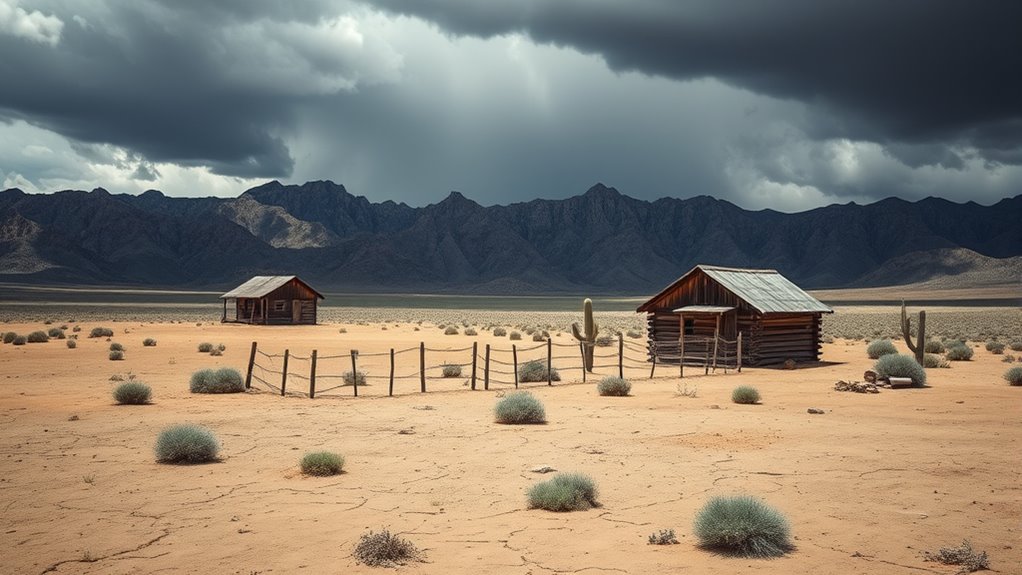Living in the Great Basin means you face unpredictable seasons with hot, dry summers and cold, snowy winters. You must manage water carefully, using techniques like rainwater collection and efficient irrigation to survive droughts. Seasonal changes may force you to migrate to access better grazing land and water sources, and you need resilience to endure harsh conditions. By understanding these survival strategies, you’ll gain a deeper appreciation for the resourcefulness required in this challenging environment.
Key Takeaways
- Homesteaders in the Great Basin adapt to unpredictable, extreme climate conditions like hot summers and cold winters.
- Water conservation is essential, with techniques such as rainwater collection and efficient irrigation to survive droughts.
- Seasonal migration helps families access better grazing land and water sources while avoiding harsh weather.
- Heavy snowfall in winter provides moisture but causes isolation, requiring preparedness for severe cold conditions.
- Resilience and resourcefulness, including water management and migration, are vital for sustaining homesteads in this harsh environment.

Living in the Great Basin meant facing some of the harshest seasons encountered by homesteaders. The climate is arid and unpredictable, with hot, dry summers and cold, snowy winters that test your resilience and resourcefulness. To survive here, you learn quickly that water is your most precious resource. Water conservation becomes a daily priority, guiding every decision from how you irrigate crops to how you store and use household water. You might employ simple techniques like collecting rainwater or using efficient irrigation methods to stretch every drop. You also develop habits to minimize water waste, recognizing that even small leaks or unnecessary use can threaten your livelihood during droughts or dry spells.
Water conservation is vital in the Great Basin’s harsh, unpredictable climate for survival and resourcefulness.
Seasons in the Great Basin are unpredictable, which means you often have to adapt quickly. During the summer, you might face intense heat that dries out the land and depletes water supplies rapidly. To cope, you may choose to plant drought-resistant crops or focus on grazing animals that require less water and are better suited to the dry environment. When winter arrives, heavy snowfall can blanket the landscape, but it’s a double-edged sword. While snow provides essential moisture for the spring, the cold can be brutal and isolating. You need to be prepared for seasonal migration, which involves moving livestock or even your family temporarily to more hospitable areas when conditions become too severe. This movement is crucial to avoid losing your animals or risking your survival.
Seasonal migration isn’t just a necessity; it’s a strategic choice rooted in practicality. You plan these moves around weather patterns, aiming to avoid the worst of winter storms or summer droughts. It allows you to utilize better grazing land, access fresh water sources, and ensure your family’s safety. These migrations can be physically demanding, but they also teach you to read the land and the weather carefully. You develop a keen awareness of when to stay put and when to move, often relying on natural signs like the behavior of animals or changes in plant growth. This constant adaptation becomes second nature, helping you endure the extreme conditions while maintaining your homestead.
Living here means embracing a lifestyle that’s deeply connected to the land and its rhythms. Water conservation and seasonal migration aren’t just strategies—they’re necessities that shape your daily routines and long-term plans. You become resilient, resourceful, and deeply attuned to the environment, knowing that survival depends on respecting and working with the land’s unpredictable nature. In the Great Basin, hardship fosters ingenuity, and those who thrive are the ones who learn to adapt swiftly and wisely to the relentless seasons. Developing skills such as water conservation techniques enhances your ability to survive and sustain your homestead in this challenging environment.
Frequently Asked Questions
What Were Common Water Sources for Great Basin Homesteaders?
You relied on underground reservoirs and surface springs as common water sources. Underground reservoirs stored water from rainfall or snowmelt, protecting it from evaporation and contamination. Surface springs, naturally occurring where groundwater reaches the surface, provided accessible water in certain areas. These sources were crucial for daily needs, farming, and livestock, especially in the arid Great Basin where water was scarce. Proper management of these sources was essential for survival in harsh conditions.
How Did Settlers Adapt to Unpredictable Weather Patterns?
You adapt by embracing seasonal strategies, planning your planting and harvesting around unpredictable weather, and building climate resilience into your homestead. You stay flexible, adjusting your routines with changing seasons, conserving water during droughts, and storing supplies for harsh winters. You learn to read the land’s signals, making proactive choices that help you survive and thrive despite the unpredictable weather patterns. Your resilience becomes your greatest tool.
What Crops Thrived Despite the Harsh Climate?
You find that drought-resistant crops like barley, beans, and alfalfa thrive despite the harsh climate. By practicing seasonal planting, you maximize your harvest and reduce risk during unpredictable weather. These crops are resilient, requiring less water and adapting well to dry conditions. Your careful planning and choosing the right plants help guarantee a steady food supply, even when the weather isn’t cooperating.
Were There Any Indigenous Practices That Aided Homesteaders?
Yes, indigenous practices greatly aided homesteaders. You can tap into native knowledge of indigenous farming, which includes planting drought-resistant crops and utilizing natural water conservation techniques. These methods helped you adapt to the harsh climate and improve your chances of success. By learning from native communities, you gain valuable insights into sustainable farming practices that thrive despite challenging conditions, increasing your resilience and productivity in the Great Basin.
How Did Isolation Impact Community Development?
Isolation shapes community development by fostering rural solitude and forging communal resilience. You find that, in remote areas, people rely on each other more, sharing resources, skills, and support. This shared dependence creates tight-knit bonds, making the community stronger despite physical distance. You notice that the challenges of solitude encourage cooperation, while resilience grows through collective effort, turning isolation into a source of strength and unity.
Conclusion
Living in the Great Basin means facing tough seasons, but resilience is key. For example, imagine a homesteader who plants drought-resistant crops and prepares for winter early—showing that adaptation and perseverance help overcome nature’s challenges. Your journey might be similar; by embracing the land’s harshness and planning wisely, you can thrive despite the odds. Remember, strength and foresight turn difficult conditions into opportunities for growth and success.










